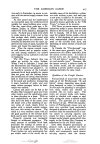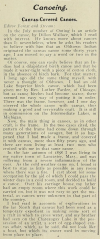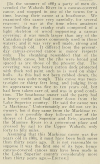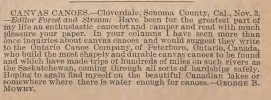Howard Herman-Haase
hcubed
In my recent article "Did B. N. Morris Build the First Wood-Canvas Canoe?" Sensing some misunderstanding regarding Morris's claim I'm beginning with a brief clarification. The article presented Morris sources that clearly indicate he originally built his canvas canoes like the birch bark, but "adopted" the "method of the solid-planked shell" in 1887. I introduced the term "Gerrish-style canoe" to describe a canvas canoe built and designed like a birch-bark to distinguish them from the later, wood-canvas canoes. Morris provides no details about this method, nor about how or where he got the idea to use it. In 1912 he denied any claim to be the first "to conceive the idea of canvas as a skin for a canoe, as it originated from the patching of bark canoes with light cloth with pitch to cover the seams..." But he but did seem to claim that the new construction method was original with the Morris, but I interpret this to mean he was the first to switch methods from loose-planking to the solid planked shell, NOT that he necessarily invented the latter method. But even if Morris borrowed, there would have been considerable work to adapt them to build the Gerrish-style canoes.
I came across an interesting letter to the editor in Forest and Stream from an F. H. Thurston. Most of the letter describes how he built a canvas and frame canoe in 1858 (not included), but it starts with a brief response to a claim made by Dillon Wallace in his 1910 essay The American Canoe in Outing Magazine. Wallace claimed that the first canvas canoes were conceived and built by the Penobscot Indians in Old Town "nearly thirty years ago" (1880) and should therefore be called Old Town canoes. My article included some pictures of indigenous canvas canoes from as early as 1881, and there is evidence that canvas use was fairly widespread. But both Morris and especially Thurston seem to be implying that the idea to cover a bark canoe with canvas was not so radical and could have happened many times and many places. Thurston points out that he himself had covered an old bark canoe with canvas many years before, which was still in use. In support of this notion the Forest and Stream editor included a description of what sounds like a 28-30 foot Gerrish-style canoe he saw on the Wabash River in 1883 that was likely built earlier than Wallace's date. He described it as "very well made, strong and dry, though old. It differed from the present day canvased-cover canoe in minor respects only. The sheathing resembled that of the birchbark canoe, but the ribs were broad and spaced as are those of the present day." It was called "a Mackinac" canoe, but we don't know when, where, or by whom it was built. It seems to me this information supports the notion that was likely lots of experimenting with using canvas on birch barks, making unlikely will ever know the "first occurrence" of such a canoe. Gerrish still has the earliest claim (1872 from Rollin Thurlow's article, and may have been the first; but be that as it may at least we know it was Gerrish's canoes that began the continuous tradition of canvas canoe building in Maine that would eventually produce the wood-canvas canoe. In light of Morris's descriptions of just how radical and important the change in construction was for the popularity of the canvas canoes, I do find it a bit perplexing how writers like Wallace and the editor, who acknowledged these canvas canoes were originally built like bark canoes, still draw a direct line to the modern wood-canvas canoes without noting the significant changes in the building methods. Perhaps you needed to be a builder to appreciate that having sheathing "that resembled that of a birchbark canoe" constituted something more than a minor difference. I am not sure "Gerrish-style canoes" is the best term, perhaps more neutral "canvased-covered bark canoe" would be appropriate, but these do seem to have been a unique type of canoe worthy of a distinct name, and lasted a bit longer than we may have thought.



An important question is, where did Morris (or someone else) get the idea of the solid planked shell for the Gerrish-style canoes? I think the most likely source was the work being done in Canada, where canoe forms were already being used and Stephenson had patented the idea of covering his cedar strip canoes in 1878. But Stephenson doesn't seem to have put any of these canoes into production at the time. I have thoroughly searched Forest and Stream for references to canvas canoes from the 1870s to 1890 (the year Gerrish and Morris published their first ads) and the only reference to a planked canvas canoe (as opposed to the canvas and frame cruising and sailing canoes that dominate the national press at his time) is a letter entitled Canvas Canoes that appeared in 1886. The author praised the virtues the canvas canoes sold by the Ontario Canoe Company. However, canvas canoes are not mentioned in the information on OCC in the Canoe Museum and there are no catalogs in the WCHA catalog collection. But it would appear they were selling canvas canoes, perhaps by special order. These canoes were likely Stephenson's longitudinal cedar strip or rib and cedar canoes covered in canvas, and they were being sold the year before Morris adopted his new method. There is still no direct path to Morris but verified production and sales makes that connection all the more possible, especially when you have a boat building brother. Are these canvas canoes wood-canvas canoes? An interesting question for another time.

I came across an interesting letter to the editor in Forest and Stream from an F. H. Thurston. Most of the letter describes how he built a canvas and frame canoe in 1858 (not included), but it starts with a brief response to a claim made by Dillon Wallace in his 1910 essay The American Canoe in Outing Magazine. Wallace claimed that the first canvas canoes were conceived and built by the Penobscot Indians in Old Town "nearly thirty years ago" (1880) and should therefore be called Old Town canoes. My article included some pictures of indigenous canvas canoes from as early as 1881, and there is evidence that canvas use was fairly widespread. But both Morris and especially Thurston seem to be implying that the idea to cover a bark canoe with canvas was not so radical and could have happened many times and many places. Thurston points out that he himself had covered an old bark canoe with canvas many years before, which was still in use. In support of this notion the Forest and Stream editor included a description of what sounds like a 28-30 foot Gerrish-style canoe he saw on the Wabash River in 1883 that was likely built earlier than Wallace's date. He described it as "very well made, strong and dry, though old. It differed from the present day canvased-cover canoe in minor respects only. The sheathing resembled that of the birchbark canoe, but the ribs were broad and spaced as are those of the present day." It was called "a Mackinac" canoe, but we don't know when, where, or by whom it was built. It seems to me this information supports the notion that was likely lots of experimenting with using canvas on birch barks, making unlikely will ever know the "first occurrence" of such a canoe. Gerrish still has the earliest claim (1872 from Rollin Thurlow's article, and may have been the first; but be that as it may at least we know it was Gerrish's canoes that began the continuous tradition of canvas canoe building in Maine that would eventually produce the wood-canvas canoe. In light of Morris's descriptions of just how radical and important the change in construction was for the popularity of the canvas canoes, I do find it a bit perplexing how writers like Wallace and the editor, who acknowledged these canvas canoes were originally built like bark canoes, still draw a direct line to the modern wood-canvas canoes without noting the significant changes in the building methods. Perhaps you needed to be a builder to appreciate that having sheathing "that resembled that of a birchbark canoe" constituted something more than a minor difference. I am not sure "Gerrish-style canoes" is the best term, perhaps more neutral "canvased-covered bark canoe" would be appropriate, but these do seem to have been a unique type of canoe worthy of a distinct name, and lasted a bit longer than we may have thought.



An important question is, where did Morris (or someone else) get the idea of the solid planked shell for the Gerrish-style canoes? I think the most likely source was the work being done in Canada, where canoe forms were already being used and Stephenson had patented the idea of covering his cedar strip canoes in 1878. But Stephenson doesn't seem to have put any of these canoes into production at the time. I have thoroughly searched Forest and Stream for references to canvas canoes from the 1870s to 1890 (the year Gerrish and Morris published their first ads) and the only reference to a planked canvas canoe (as opposed to the canvas and frame cruising and sailing canoes that dominate the national press at his time) is a letter entitled Canvas Canoes that appeared in 1886. The author praised the virtues the canvas canoes sold by the Ontario Canoe Company. However, canvas canoes are not mentioned in the information on OCC in the Canoe Museum and there are no catalogs in the WCHA catalog collection. But it would appear they were selling canvas canoes, perhaps by special order. These canoes were likely Stephenson's longitudinal cedar strip or rib and cedar canoes covered in canvas, and they were being sold the year before Morris adopted his new method. There is still no direct path to Morris but verified production and sales makes that connection all the more possible, especially when you have a boat building brother. Are these canvas canoes wood-canvas canoes? An interesting question for another time.

